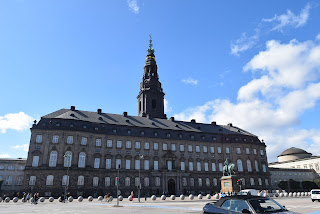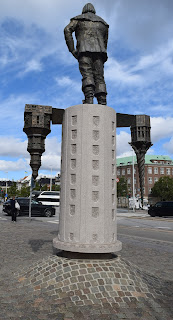 |
| The Iconic coloured buildings of Nyhavn |
Morning
I woke at 5am local time (4am UK time) on Tuesday morning and got up and drafted the blog post for yesterday and uploaded all yesterday's photos to Flickr.
I used the coffee bags provided to make coffee for Drew and myself at about 7am, then had a shower. This hotel is very eco-friendly but I must admit that the idea of having two not very bright lights in the bathroom makes the bath at one end and the shower at the other somewhat gloomy. When I'd pulled the shower curtain across to stop wetting the rest of the room, gloomy became dark - luckily I was using my own shower gel and shampoo as I couldn't read the bottles to see which was which of the eco stuff provided by the hotel. Still the shower was pleasantly warm and had my favourite layout of one overhead showerhead and the other showerhead that is flexible, so I could cope in the dark😂.
Kalvebod
Starting the day gently we headed out at 10am. As it was our first day, we used our normal - let's wander and see what we find - methodology. This paid off really well making for a delightful day.
 |
| Istedgade |
I'd decided that our first direction was to get from the hotel to the canal. I say the, there are so many in this city that I should have said a! Still, walking out of the hotel we walked along Istedgade until we came to the Central Railway Station,
turning right alongside the railway lines we came to Tietgensgade which is one of the roads which bridges the multiple railway lines coming out of the station. Saying there are at least 22 platforms may give you an indication of just how many lines we crossed above.
From Tietgensgade we turned left onto Bernstorffsgade and came to the large canal at the waterfornt area called Kalvebod Brygge i.e. Kalvebod Quay by the modern Engineering Institute building.
A side note - we often have full breakfasts while on holiday and it is still possible that we will have a full breakfast on some of the mornings at the hotel, but as breakfast isn't included in the room price (not uncommon in continental hotels) we didn't feel the need to eat a lot this morning after the generous meal at Pho Hanoi the night before. So, we had decided to eat something on the journey, so we stopped at Espresso House for this purpose.
Drew opted for Focaccia with ham and cheese
while I had a delicious Rye bread with chicken, pickled onions, jalapeño cheese, baby spinach and ajvar (the latter which is a red pepper and aubergine paste which is not uncommon here and has a zingy taste and a gentle texture).
We had a latte and americano to wash them down.
Slotsholmen
From our breakfast stop we went on via Hans Christian Andersen's boulevard
to Slotsholmen, the island which has been the centre of Danish government and power since 1167, when the first Castle was built here.
The island includes the current Christiansborg Palace the Borgen, or Castle, which gives the political TV drama its name.
The quiet opening that sits beside the Danish War Museum leads through to the amazing square called Rigsdagsgården in which the Christiansborg Palace is located.
Opposite the Castle is the Garden of the Royal Library with its amazing lake and fountain [Co-pilot's note: and duck house!!]
and statues of the first Existentialist philosopher Soren Kierkegaard and the first Danish commoner to be raised to the ruling elite, Peder Griffenfeld.
The front of the Palace is dominated by a large equestrian statue of King Frederick VII,
the King who established the constitutional monarchy that Denmark is today. He was succeeded by his cousin Christian VIII, familiar to me through his role (small on TV, large in history) in the Prusso-Danish War of 1864 which saw the end of Danish rule in Schleswig and Holstein, dramatised in the series 1864.
Christian IV's Gamle Børssal
Across the main road (Slotsholmsgade) from the Christiansborg Palace is the Gamle Børssal (Stock Exchange) of Christian the Fourth.
Though undergoing renovation at present, it still stands out as a striking building, especially its spire, seen behind the King's statue, which is very distinctive.
Also distinctive is the statue of King Christian IV which has the spire/tower of both buildings around here pointing down beside him.
Christian is perhaps best known to British people as the brother of Queen Anne, the consort of James VI of Scotland and I of England.
Knippel's Bridge
While it had been our initial plan to walk across to Holmen's Kirk opposite the Castle, when we walked to the end of the Borse we came to Knippel's Bridge and found the modern bridge to much of a temptation.
The Bridge crosses the canal from Slotsholmen to Christianshavn one of the more bohemian parts of the City.
As we cross, we see one of the ferry buses pulling into the 'bus' stop and Drew reminds me we saw one episode of Nordic Noir where someone was found dead on one of these boats - though we also watched Below the Surface where 15 people were kept hostage on the Copenhagen Metro - so based on our viewing no one would travel anywhere in the City!!
Christianshavn
Christianshavn has a very different feel from the other side of the canal, with lots of coffee shops and bakeries and artists displays it is clearly a part of the city where people live, rather than simply a tourist destination.
We were shortly crossing the Christianshavn canal which is smaller than the main canal we had recently passed over. It has bars on canals along the water and is prettily tree lined.
Though the Christian mentioned in the area's name is the Danish Monarch Christian IV who built these islands on reclaimed land as part of his fortification of the City, the religious Christian community is well represented in the area with two large Danish National Church buildings, both of which we visited.
The first the Church of Our Saviour is spectacular.
It was built in the 1680s and includes a 1698 organ whose pipes appear to be held aloft by elephants.
There are too many amazing images from inside this Church - if you want to see all of them you are welcome to look at them on Flickr, start here and click/swipe left (there are 32 photos).
From Our Saviour's Church we walked through the busy streets of the area until coming to Christian's Church
this large church looks very alien to my Catholic eyes. More like a large auditorium than a church. You can see that it has balconies like a theatre on three of its sides - photos start here on Flickr. It was used by the German Community in the heyday of Denmark's role as a great trading nation. Though its Germanic links died down after a coup d'état in January 1772, when Christian VII's Prussian-born anaesthesiologist and adviser Struensee was deposed and executed, the Ordinance on Immigration was introduced in 1776, this law stipulated that all official positions in the country were to be filled by members born within the Danish monarchy, so Germanic influence and presence declined as did the church here.
Holmen's Church
We hadn't planned to see so many churches today, but do regularly visit churches so Drew can take photos of stained glass to get the views of our friend and stained-glass enthusiast, Robin. So far stained-glass has been largely absent from the churches we have visited, not suiting the 'evangelical Lutheran' tradition of the Danish National Church.
As Holmen's Church shows, this lack of stained glass is easily replaced by other art forms - including portraits, fine carved wood and marble.
The church, converted from a warehouse when the quay was moved further away with the building of the additional islands in 1619 is, as well as a parish church, a church dedicated to the Danish Navy with many signs of the naval tradition including a boat in the centre of the building
and Admiral's graves outside.
Again, Flickr has many more (42) photos - start here and swipe/click left.
It was now 1.30pm and though there are many more places for us to visit, it seems appropriate to stop this blog post here and continue into our later visits in another post.
How to sum up my first morning and early afternoon in Copehagen. Well I wrote a brief note on leaving Holmen's Church before heading on to the rest of the day's exploring - it simply says: "Wow - what a City" and seems to sum up the pleasures of the day.





























I’m exhausted just reading your blog and that was only the morning but thanks for sharing. It’s the sort of meander around the city I would have done in times past but of late and finding my walking activities a little curtailed.
ReplyDeleteHi Mallcolm,
DeleteSorry to hear your walking is curtailed. Since retirement my walking has greatly improved, helped by a five day a week walk to church and back (four miles round trip) for the first four years and then a five mile a day for six days (also a round trip, but up through Taffs Well not down towards the City) since the start of the first lockdown. I've never been able to walk so far in my life!
Hope your last few days of the cruise goes well - I've enjoyed your trip virtually, so hope you'll enjoy the rest of our visit here.
you took me down a rabbit hole of the schleswig - holstein question, one which I failed to negotiate in my A Level History, and am not much nearer the answer now - the arbitrary boundaries of state eh...
ReplyDeleteI have no idea how historical the programme shown on BBC4 was, but it provided a good mix of personal drama with big picture.
DeleteLater in the day I came across a statue of one of the political and religious leaders who was (according to the programme) very keen on the war - Grundtvig
Lack of stained glass in the Luteran region is understandable. I'm just back from the very Catholic part of Germany west of the Rhine: PLENTY of stained glass to be seen!
ReplyDeleteExcellent,
DeleteI'm planning on catching up with your recent photo set on Flickr when in the hotel on WiFi while Drew is running around the streets of the City on Sunday.
Warning to regular readers: Haydn will occasionally name drop you, to see if you are paying attention. He used to do this sort of thing when he was teaching.
ReplyDeleteGuilty as charged - I would slot a name in just to check who was paying attention. But in this case I was genuine in apologising for the absence of stained glass in this year's holiday for you.
DeleteWe must plan it better while, of course, looking at your stained glass photos on Flickr.